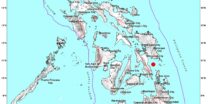By Noel R. Cabobos
BORACAY ISLAND, Aklan — In 2018, the Environment Department conducted its geo-hazard and hydrogeological mapping here in Boracay Island as part of the rehabilitation program as ordered by the Duterte administration.
The study revealed a ‘depressing’ situation of the island: the world’s best island is peppered with sinkholes.
And the worst is yet to come — most parts of the island are susceptible to future land depressions.
Certain officials kept the information under wraps to downplay its possible impacts on the country’s No. 1 tourism generator.
But although only a few people knew the study’s results, the DENR immediately advised the local government unit of Malay to seriously start implementing measures to limit infrastructure development on the island.

They warned that the sinkholes in three barangays might seriously affect Boracay’s carrying capacity. If further development continues and if more people come to the island, the sinkholes will likely multiply.
The advice fell on deaf ears.
The findings
Using both the Light Detection and Ranging (LiDAR) and Interferometric Synthetic Aperture Radar (IFSAR) technology to determine land depressions in Boracay, the DENR’s Mines and Geosciences Bureau (MGB) validated the presence of 789 sinkholes in three barangays — Balabag, Manocmanoc, and Yapak in 2018.

The number of sinkholes, according to MGB, went up to 801 in 2019, 814 in 2020, and 815 between 2021 and 2022.
Also discovered are 534 cave openings or keyholes leading to some large underground open spaces.

Residents will not be able to see the sinkholes and cave openings with the naked eye. They are all beneath the island. Boracay, the MGB explained, is made of limestone, which makes it susceptible to land depressions.
“When exposed to acidic water, limestone slowly melts and overtime this creates sinkholes,” said Mae Magarzo, chief of the MGB Geosciences Division in Western Visayas.
Both curse and blessing
Through the years, Boracay has been famous for its powdery white sand. Travelers and critics voted the island as the best in the world.
Boracay boasts of its finest sand in the world. Tourists swear they can walk barefoot on the sands during the hottest hour of the day.
The chemical composition that makes the sand so fine is the same thing that creates a lot of sinkholes on the island. Calcium carbonate produces limestone. When swept ashore, calcium carbonate forms tiny white specks of sand.
Thus, the island’s chemical properties are both a blessing and, perhaps, a curse for the island’s tourism.
Malay mayor: ‘Walang kamalay-malay’
On December 12, Regional Executive Director Livino Duran briefed the media in Iloilo City on their latest findings in Boracay.
Malay Mayor Frolibar Bautista claimed that there has never been a report of sinkholes on the island.
He said he was surprised by the DENR report. He claimed the DENR did not inform him about the new report, purportedly of the increasing presence of sinkholes.
Bautista assured the public that there was no cause for people to panic. He said the local government had instituted measures to ensure that the island’s carrying capacity would not exceed its limits.
LGU and DENR at odds
In 2018, after validating the presence of sinkholes on the island, Val Tabero, head of the provincial environment and natural resources office in Aklan at that time, strongly advised Malay LGU to start limiting the development on Boracay island due to the prevalence of sinkholes.
During that year, a study commissioned by the DENR bared that Boracay has a tourist carrying capacity of 19,215 or a daily total of 6,405.
Officials of Malay did not heed the advice. Instead, they asked DENR Executive Director Duran for a second opinion. But Duran issued the same assessment to limit the number of tourists and further development on the island.
In 2018, the Department of Education was supposed to construct two- to three-story school buildings in Barangays Manocmanoc, Balabag, and Yapak. But the DENR rejected the school project as the satellite confirmed the presence of sinkholes underneath school sites, particularly in Balabag Elementary School.
SB inquiry in aid of legislation
Malay’s newcomer Sangguniang Bayan members Alan Palma Sr. and Vicky Aguirre-Salem called for a “heart-to-heart talk” between the DENR and Malay LGU to thresh out their differences on risk management.
Both said that an inquiry in aid of legislation should address the varied concerns regarding the sinkhole problem and its effects on the country’s economy, especially since Boracay has become the jewel and tourism pride of the country.
“The DENR report is very disturbing. It could have been better if they had submitted the report to us firsthand before it was shared with the media. We are now in the super peak season, and there could be implications in our tourism industry,” Palma said.
Alan said the Sangguniang Bayan will invite the DENR to share its scientific and technical assessment about sinkholes and “hopefully we could work hand-in -hand.”
“Details must be presented. What are the structures that are at risk? What are their recommendations? It is better if we could both firm up mitigation measures and once and for all call the attention of all stakeholders and thoroughly explain to the public what is really going on,” he added.
‘Fast’ development
However, the development and commercialization of Boracay apparently went beyond proper planning and zoning. Observers say it was too fast, as infrastructure development directly affects the environment.
The national government intervened in the management of Boracay in 2018 after President Duterte declared the island a “cesspool.” The Boracay Inter-Agency Task Force established a holistic approach to reverse the effects on the environment of critical projects and, little by little, the massive development on the island.
The Task Force ended its term on June 30 this year and reverted to the LGU the complete control of the frontline responsibility over Boracay. Many questioned how Boracay could sustain the gains already achieved during the island’s healing period.
banner photo by Noel Cabobos, other photos courtesy DENR








